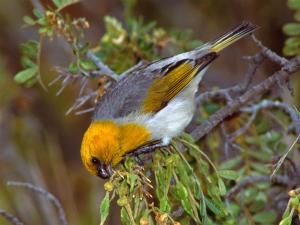New Report on Endangered Palila Conservation Biology
University of Hawaiʻi at HiloThe U.S. Geological Survey today announced the availability of a report, "Palila Restoration Research, 1996−2012,"which summarizes long-term studies on the conservation biology of the palila (Loxioides bailleui), a critically endangered Hawaiian forest bird found only on the upper slopes of Mauna Kea Volcano. With the publication of this report, the palila becomes the most thoroughly documented Hawaiian bird species. Topics covered in this extensive report include population dynamics and restoration research, demography and breeding ecology, predator ecology and management, and habitat use, food ecology, and vegetation ecology, and management implications.
The report details how research results can be applied to the conservation of the palila and restoration of its habitat. “Some results can be expected to have immediate, practical value; whereas, other information is more likely to enlarge our understanding of the species so that conservation strategies can be adjusted as conditions change,” said Paul Banko, USGS biologist and co-editor of the new volume.
The major goal of the population and restoration research was to develop methods for reintroducing palila to former range and for enhancing the main palila population on the western slope of Mauna Kea. This work involved evaluating sites where palila could be reintroduced, translocating wild palila to northern Mauna Kea to start a new colony (supplemented by palila bred in captivity by the San Diego Zoo). Translocating palila proved successful in establishing a small breeding colony of palila on the northern slope of Mauna Kea that persisted for a number of years before disappearing during severe drought.
A key aspect of the research was documenting the roles of drought and habitat damage by feral sheep in the sharp decline in palila numbers after 2003. One of the outcomes of the decline was the disproportionate number of male palila in the population, suggesting that females suffered greater mortality under stressful conditions. Although palila were found to be at lower risk for mosquito-borne diseases than are most other Hawaiian birds, their reproductive capacity is low, based on studies of the demographic characteristics of the breeding population, productivity of breeding pairs, and nesting success.
Introduced predators are a longstanding threat to Hawaiian birds, but before this research little was known about their ecology in upland Mauna Kea, their level of threat to palila, or methods for their control. Radio-telemetry was used to track feral cats, mongooses, and rats to determine home range characteristics and activity and movement patterns. Diet studies revealed the roles of cats and mongooses as bird predators. Surveys revealed that populations of rats were relatively small compared to wet forest habitats and that large outbreaks of mice occasionally occurred. This new knowledge of small mammal ecology was applied to understanding the impacts of these invasive predators on palila and other forest birds and to refining control methods.
Due to the palila’s extreme dependence on the seeds and other resources provided by a single native tree, māmane (Sophora chrysophylla), its survival critically depends on the availability of that food and the quality of the māmane habitat. Native Cydia caterpillars, which also eat māmane seeds, were found to be another critical food source for palila, especially nestlings. These topics are discussed in chapters on palila home range characteristics, patterns of habitat use and foraging behavior, seasonal patterns of māmane flowering and seed set, and threats to māmane resources from invasive wasps, ants, and beetles. Chemical analyses revealed that māmane seeds have high nutritional value but also contain high levels of potentially toxic secondary compounds, which might sicken or kill other birds that have not evolved tolerance to these compounds.
The chapters in the section on vegetation ecology characterize the plant community in subalpine Mauna Kea to understand how palila recovery will be affected by existing and future habitat conditions and to identify areas where habitat restoration should be targeted. Palila Critical Habitat has been degraded for over a century by a variety of introduced ungulates, but especially sheep (both feral and European mouflon) and goats. Since 1980, sheep and goat populations have been culled by public hunting and aerial shooting. This has led to widespread regeneration of māmane and other native plants, although vegetation recovery has been slow and uneven. Many species of weeds have also invaded subalpine Mauna Kea, further disturbing the native vegetation. Field surveys and analysis of satellite imagery revealed the sparse distribution of māmane and other important native species around Mauna Kea, and the damage done by ungulates was quantified. The distribution of 15 of the most threatening invasive weeds was also mapped, and the consequences of fire for the subalpine vegetation were evaluated.
The report has been published by the University of Hawaiʻi at Hilo’s Hawaiʻi Cooperative Studies Unit as part of its technical reports series. This document and the research contained within represents the collaborative partnership between researchers from USGS and UH Hilo that has made these studies possible. Edited by USGS researcher Paul Banko and Chris Farmer of the American Bird Conservancy and with contributions from 23 other authors from UH Hilo and other partners, the new report highlights years of work of many hundreds of technicians and volunteers.
Palila research was supported by the Federal Highway Administration; U.S. Army Garrison-Hawaiʻi, U.S. Geological Survey Wildlife Program, U.S. Fish and Wildlife Service, and Hawaiʻi Division of Forestry and Wildlife and conducted in partnership with the University of Hawaiʻi at Hilo.
The full report, Hawai‘i Cooperative Studies Unit Technical Report HCSU-046, “Palila Restoration Research, 1996−2012,” by Banko, P. C., and C. Farmer, published by the University of Hawai‘i at Hilo, can be found online. An accompanying summary report is also available.
IFrame URLs: http://gallery.usgs.gov/photo_shares/thumbs/tags/NR2014_11_05/1
USGS provides science for a changing world. Visit USGS.gov, and follow us on Twitter @USGS and our other social media channels.
Subscribe to our news releases via e-mail, RSS or Twitter.
Links and contacts within this release are valid at the time of publication.

